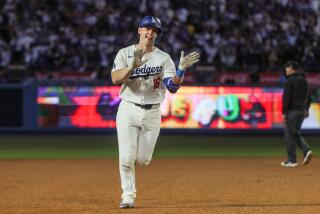The Hall Greets a Wizard
It is uncertain whether Ozzie Smith will somersault across the Cooperstown stage today and directly into the Hall of Fame.
The Wizard of Oz, at 47, may not be able to generate the acrobatics that characterized his highlight-reel performances as one of the greatest fielding shortstops of all time and enabled him, said Jack Clark, the Dodger hitting coach and a Smith teammate with the St. Louis Cardinals, to “demoralize” the opposition with his glove alone.
“It was magical,” Clark said. “You’d be in awe of something he’d do every day. He would literally shut down rallies by himself, and that affected other teams and the way they swung the bats. You could see them try to hit the ball away from him, [but] there was no offense for his defense. He was that far above everyone else.”
So, maybe there won’t be a trademark back flip when the graying Smith steps to the podium today.
Maybe we’ll have to freeze that memory in the camera of the mind.
It is enough that Smith’s induction--like Bill Mazeroski’s last year and Brooks Robinson’s in 1983--serves as a Gold Glove reminder of the importance of defense, and much more.
It is the ultimate reminder of how far Smith traveled after leaving Locke High in 1973, when few were doing back flips over his athletic future, his comparatively small stature questioned by the professional clubs that did not draft him and by the college recruiters who did not pursue him--even though they all saw him.
They poured into Southern California that spring. They came to see another shortstop, a promising kid named Robin Yount, who played at Woodland Hills Taft High and would become a first-round pick of the Milwaukee Brewers. And they stopped at Locke to watch a first baseman named Eddie Murray, who would be drafted by the Baltimore Orioles in the third round, and a left-handed pitcher named Darrell Jackson, who would play at Arizona State and later spend five years with the Minnesota Twins.
Tom Hinkle, then an assistant coach at Cal Poly San Luis Obispo, made three trips to Locke to scout Jackson and try to recruit him and each time--nudged by Phil Pote, a longtime scout who was then teaching at Locke--came away more impressed with Smith.
“Every scout in Southern California had to have seen Ozzie that year, but he was the kind of player who had to grow on you,” said Hinkle, now retired and living in Atascadero after 15 years in coaching and more than 20 as a professional scout who signed Randy Johnson, among others. “You had to get past how small he was at the time, but here was this little guy playing shortstop and I would say to myself, ‘Geez, this guy can play.’
“He had great hands, great quickness with his feet, and from Day One I knew he was definitely something special defensively. I didn’t know how much he would hit because of his size, but I knew he was special with the glove.
“We were a Division II school at the time and when I went back to tell [Berdy Harr, the late Cal Poly coach whose widow, Jeanne, will be in Cooperstown today], I said, ‘Berdy, this is an acrobatic Division I shortstop who has great body control, but don’t be surprised when you see him because he looks like a Pony Leaguer.’ Berdy said, ‘What do you mean by that?’ and I said, ‘Well, he’s only about 5 feet 7 and 118 pounds, but he plays beyond his size.’ He was just immature physically. You hoped he’d get stronger physically, and he did.”
Hinkle has since been credited with seeing what others didn’t, with giving Smith an opportunity others wouldn’t, but he’s not sure about that, insisting Pote would have made sure Smith got a chance to continue playing somewhere.
“The irony is that Ozzie had already applied at Cal Poly [on an academic scholarship], and neither Berdy nor I knew it,” Hinkle said. “He planned to walk on in the fall. I’m sure we’d have seen flashes of how good he was, but sometimes you can get lost among 60 or so walk-ons. As it was, he was so good as a freshman that we moved our all-league shortstop to first base to make room for him.”
Even then, Hinkle said, Smith brought his trademark back flip, his defensive flair, to Cal Poly, but the attribute that separated him “is that he was the hardest worker I ever saw in more than 35 years as a coach and scout. A lot of guys may have Hall of Fame ability, but not Hall of Fame drive and determination. Ozzie was the benchmark for me when it came to work ethic, focus and goals on the field. You would literally have to chase him out of the batting cage every night.”
It was no different after Smith was drafted by the San Diego Padres in the fourth round in 1977, no different during a 19-year career of 13 Gold Gloves, 2,460 hits and 580 stolen bases. Infield practice, Smith often said, was his favorite part of the day. He would make blind throws to first, field grounders on his knees from the cut of the grass, have someone hit pop flies into shallow left field so that he would have to turn his back to the plate and make over-the-shoulder catches.
In a recent conference call with reporters, Smith said, “Some of it may have been instinct, but I never wanted to be surprised on the field. I always wanted to know where I was at all times. I worked hard. I realized ability is like beauty. It can be very, very fleeting.
“I also never wanted to walk away from the field feeling I had cheated myself. I was blessed with the ability to do certain things and never took it for granted. I gave everything I had every day and never really stopped to admire my work. People would come up and ask me, ‘Didn’t this play or that play amaze you?’ and I’d say, ‘No, it was just a matter of instincts and hard work.’ Of course, I’ve seen some of those plays on tape since then and I have to say, ‘Damn, I was pretty good.’ ”
Indeed.
“There is no question he was the best defensive shortstop in my time,” said Yount, who served as an honorary captain at the All-Star game. “You see a lot of defensive plays now where guys slide into balls and get up and throw where years ago you wouldn’t leave your feet to make a particular play. Ozzie redefined the position in that way. I never saw a guy get back up and throw a baseball as quick as he did.”
Of course, the shortstops who are doing it now are also hitting 40 home runs a year and winning batting titles, and the $2.3 million Smith received as baseball’s highest salaried player in 1988 is now less than the average salary.
“I just hope that my going into the Hall of Fame, primarily as a defensive player, will open the door for other guys who have the ability to win a championship,” Smith said. “There will always be room for the prototypical shortstop, although the position has definitely changed. It’s crazy and unbelievable the numbers they’re putting up now, and I love watching a guy like Derek Jeter, who has got to have a distorted view about what baseball is all about because he’s been in the World Series just about every year he’s played.
“I mean, it’s fun watching what these guys can do, the numbers they’re putting up while still helping their teams defensively. It’s phenomenal.”
Smith turned himself into a respectable hitter who beat the Dodgers with a ninth-inning home run in Game 5 of the 1985 National League championship series with the Cardinals and finished his career with a .262 average, up 31 points from his first four years with the Padres.
His Cooperstown plaque will display him in a Cardinal cap, but there is bitterness to it.
Although Smith retired after the 1996 season with a six-year, $1.2-million personal services contract, he has attended only a few Cardinal functions and never helped in spring training because of a feud with Manager Tony La Russa, whom he has never forgiven for making newly acquired Royce Clayton the primary shortstop in ‘96, when Smith was coming off an injury-marred year in which he hit .199 and played in only 44 games.
“I never wanted to do anything that would damage Ozzie’s legend and legacy,” La Russa said on a recent visit to Los Angeles, “but I had to do what I felt was best for the club. Ozzie had physical questions, and I simply felt Clayton was the better player at the time.”
Smith appeared in 82 games that final season, batting .282 and helping the Cardinals win a division title, but it didn’t ease his discomfort, his belief La Russa deceived him regarding his status and created the perception that he was a problem in the clubhouse. He simply won’t rejoin the organization “until you-know-who leaves, and they understand that. I’m doing things I enjoy doing in life, and when that regime is gone I’ll be very happy to go back.”
La Russa won’t be gone for a while. In the meantime, the Wizard takes a bigger and more rewarding leap today.
More to Read
Go beyond the scoreboard
Get the latest on L.A.'s teams in the daily Sports Report newsletter.
You may occasionally receive promotional content from the Los Angeles Times.










